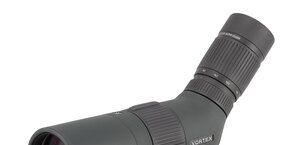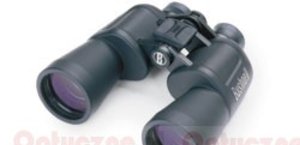Sky-Watcher BKP 150750EQ3-2 - telescope review
4. Optical properties and usage
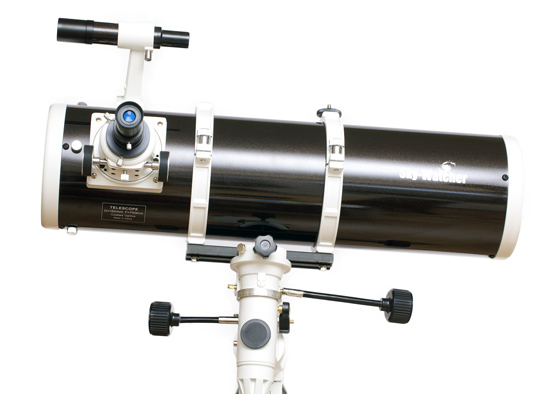 |
An old principle says there is no such thing as universal equipment. It is true as well if you want to choose an astronomical telescope. You will need one device for visual sky observing and something different for photography. If you want to observe or photograph deep sky object you will need different parameters than in the case of such objects as planets or details of the surface of the Moon. There are several rules which are simply sacred and might help you optimize the potential of your telescope. Firstly, the bigger the diameter of a telescope the more you see and more clearly. Secondly, sometimes the right localization is more important than the quality of your equipment. It would be difficult to observe galaxies or nebulae from a city centre, even if you have a big telescope; it is far better to own a smaller, portable device which enables you to go away and look for dark sky.
The Sky-Watcher BKP 150/750 tube is already so big that you can see most of Messier’s list objects through it in suburban conditions. Of course you shouldn’t expect such images like those from big observatories or The Hubble Space Telescope. Most of such objects will be visible only as delicate mists or fuzzy spots. Colors are perceptible only in the brightest objects and solely by telescopes with a big diameter (at least 35-40 cm). The instrument, tested here, can show us at best mere outlines of nebulae or galaxies and divide stars in the biggest and the brightest globular clusters. How much you can see depends also on the quality of sky under which you make your observations.
Please Support UsIf you enjoy our reviews and articles, and you want us to continue our work please, support our website by donating through PayPal. The funds are going to be used for paying our editorial team, renting servers, and equipping our testing studio; only that way we will be able to continue providing you interesting content for free. |
- - - - - - - - - - - - - - - - - - - - - - - - - - - - - - - - - - - - - - - - - - - - - - - -
If you use shorter eyepieces and the Barlow lens you can admire the phases of Venus, Jupiter’s stripes and one of the products of its atmosphere - Great Red Spot. You can also notice without any problems the rings of Saturn and, with the contemporary opposition, polar caps on Mars. You can watch details of the Moon surface (a gray filter, darkening the image, might be a useful addition here). You can even be tempted to buy a special solar filter film for Sun observations. Our day star is going toward the peak of its activity and the observations how the Sun spots are created and developed can give you a lot of joy, making you use your telescope also during the day.
It is a great device for those who are starting their astronomical adventure and want to observe sky. Low physical weight of the set and the fact that you can fit it even in a small car are big advantages. Its usage is not complicated, it is also easy to assembly and, after motorizing, it allows you to observe the skies in a very comfortable way.
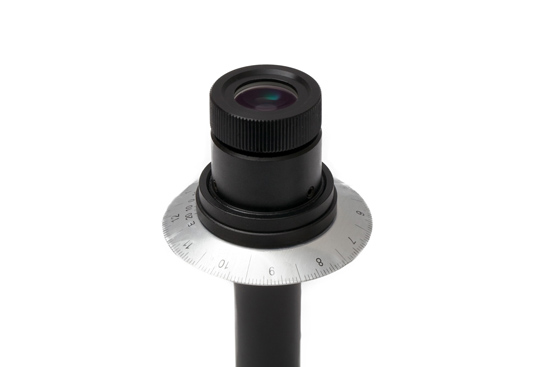 |
What’s more, because the tube is suspended on a parallactic mount, you can have a go at astrophotography. You should additionally buy a polar finder scope and a motor drive (at the beginning for one axis only). It would be the easier to put a camera on one of the telescope’s clamping rings, aim it at an interesting sky area and take a series of photos. Such a material will allow you, depending on the possibilities of your camera, to take simple shots of constellations, the Milky Way, or, using a 50-100 mm lens, even the biggest and the brightest nebulae objects. With wide angle lenses, a properly situated mount will enable you to take expositions lasting even several minutes.
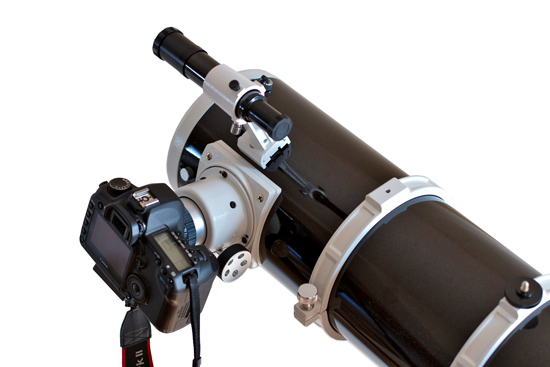 |
A bit more trouble you might experience if you want to photograph nebulae objects using the optical tube (so in the main focus of the telescope). For such photography digital reflex cameras or cameras with exchangeable optics will be the best. To attach them to the telescope you will need an appropriate adapter for the T2 socket – you screw it to the 1.25” connector which you put into the eyepiece focuser. The EQ3-2 mount, depending on the declination of the object, will allow us to get exposure times to about 60 seconds. While using a Newtonian optical tube for photography you can notice one of the optical aberrations of this type of telescopes. It is a combination of a high field curvature, which is characterized by the fact that you get a sharp image only in the centre of the frame, and huge coma, which is so to speak a part and parcel of fast parabolic mirrors. To diminish this combination of aberrations you can use a so-called coma correctors which turn our small Newtonian into an astrograph (so a telescope with a flat field of view, without coma). Because of a 2” eyepiece focuser such a coma corrector can be used without any problems in the tested telescope. Of course it is an optional part which you have to buy separately.
In order not to sound groundless, we decided to take appropriate photos and measurements. A picture below shows a compilation of crops taken from the frame centre and its corners of a photo of the sky made by a Canon EOS 300D in the main focus of the tested telescope.
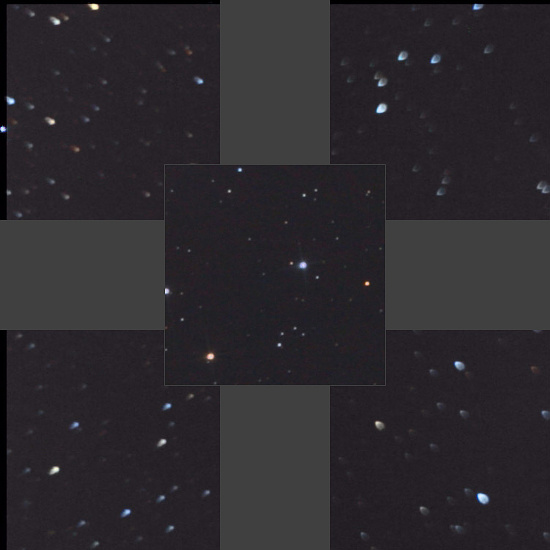 |
As the image in the centre is of good quality, with more or less point-like stars, the corners of the frame are definitely worse. You can notice significant elongation there and the images of stars are rather fuzzy. The coma and the field curvature, two aberrations we spoke about earlier, make themselves felt here. In order not to base our assessment on only visual evaluation, let’s have a glance at the results of the CCD Inspector program.
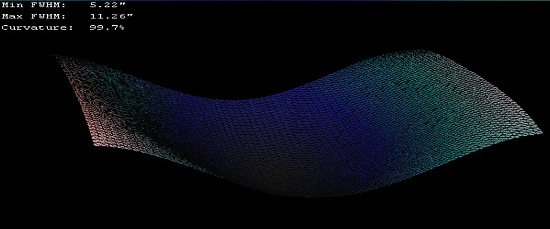 |
The field curvature is very pronounced, amounting here to as much as 99.7% (the closer to 100% you get the worse result you deal with). Full Width Half Maximum of the star images show a huge field of dispersion. As in the centre of the frame this metric is about 5.2 seconds of arc, in the corners it increases almost two times, reaching 11.3 seconds of arc.
Now let’s see how the situation changes after attaching a coma corrector.
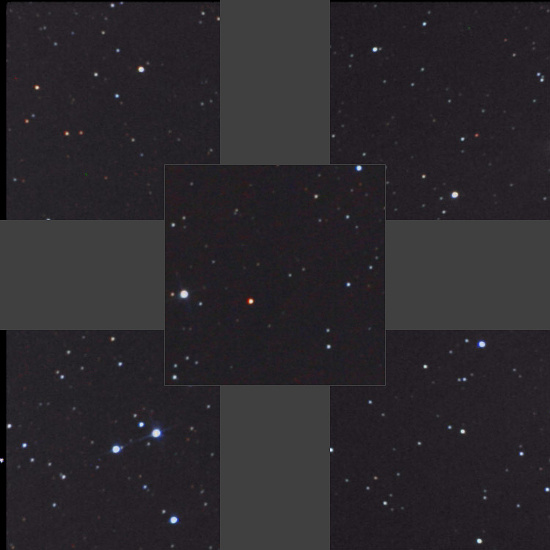 |
The difference is radical. Now it is difficult to distinguish images in the frame centre from those taken in the corner. Just as a formality let’s consult the results from the CCD Inspector.
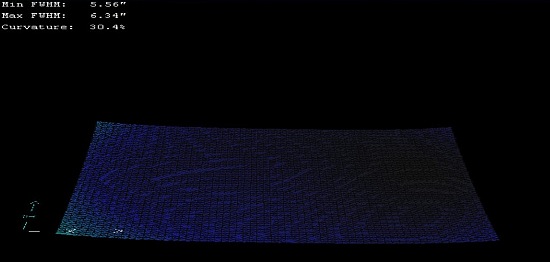 |
It can be noticed that the difference in the Full Width Half Maximum resolution of the images of stars between the centre and the corners decreased. Without the coma corrector it was over two times bigger, now the FWHM increases from 5.56 seconds of arc to 6.34 so just more than a dozen of percent. The coma is corrected very well.
The field curvature improves significantly as well, as its value reaches now 30%. It is a decent result. It’s enough to mention here that the best-corrected apochromatic quadruples for astrophotography give results slightly below 10%, and apochromatic refractors, with an additional field corrector, have values from 10 to more than a dozen percent; classic three-element apochromats without any corrector can provide results on the level of 20-30%. It’s also worth noticing that all these constructions are much more expensive than the telescope, tested here.





